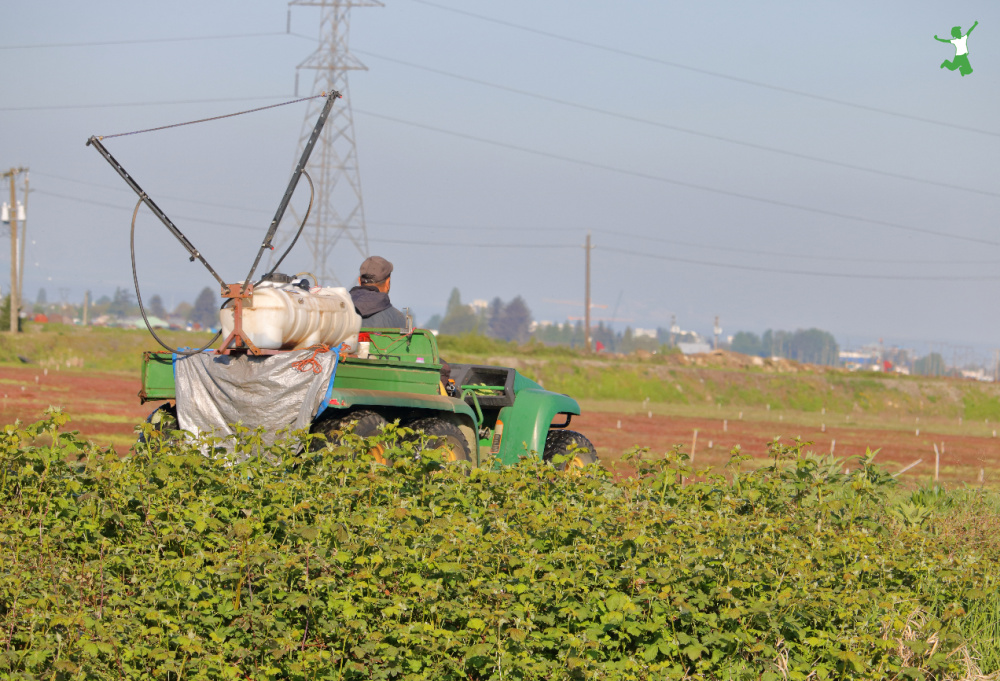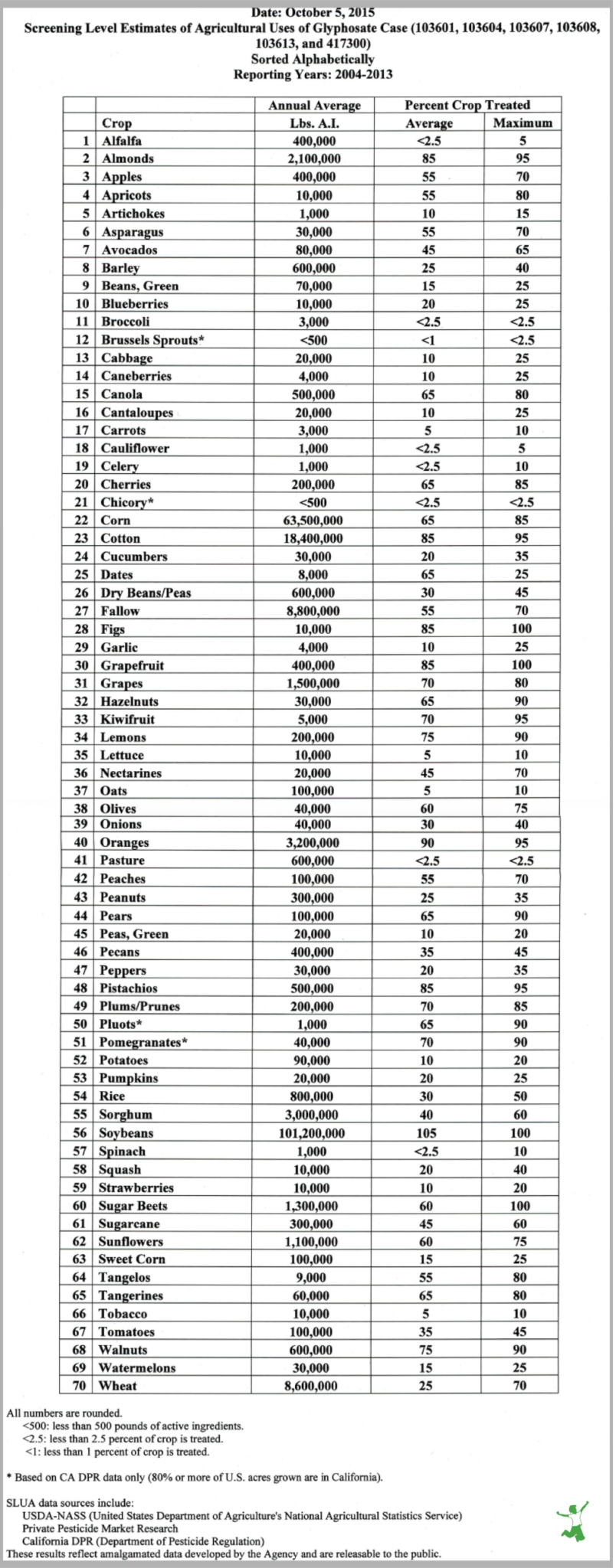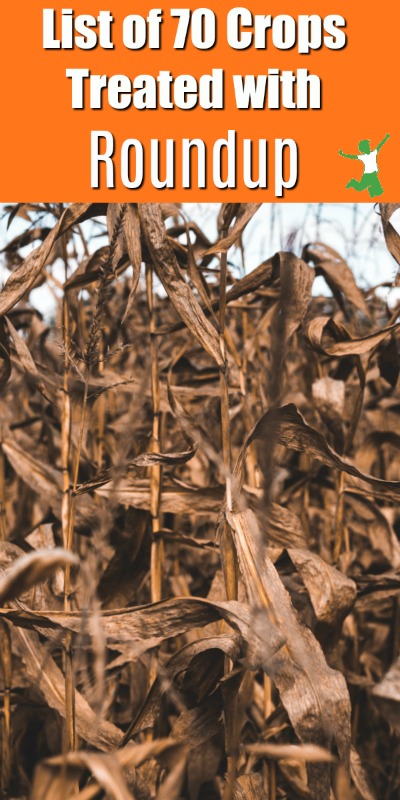Application of herbicides containing the toxic chemical glyphosate (Roundup) is common for dozens of conventional food crops, in many instances, just before harvest. The problem is not just wheat crops as commonly believed.

The application of herbicides as a (toxic) drying agent on wheat immediately before harvest is an established practice on many conventional farms.
The method was first suggested as early as 1980, becoming routine in North America over the past 15 years or so. Use is also widespread in the UK.
Applying herbicides like Roundup 7-10 days before harvest is viewed as especially helpful for wheat that ripens unevenly, a common occurrence.
It is also considered a helpful tool to initiate an earlier harvest when weather conditions threaten plant viability.
Other benefits are earlier ripening for earlier replanting and reducing the green material in the field. This puts less strain on farm machinery during harvest.
Farmers euphemistically call the practice “desiccation”. When used during wheat harvesting, it can result in a slightly greater yield by triggering plants to release more seeds.
The result?
Most non-organic wheat in North America is now contaminated with glyphosate, the active ingredient in Roundup and similar herbicides.
Glyphosate is Carcinogenic
A March 2015 report by the World Health Organization identified glyphosate as a probable human carcinogen. (1)
Several EU countries have banned Roundup as a result.
However, in North America, glyphosate use shockingly continues to remain popular in the conventional farming community.
As it turns out, the use of Roundup as a drying agent on wheat prior to harvest is just the tip of the iceberg.
Dozens of other food crops are subjected to dousing with glyphosate just prior to harvest as well.
This misguided and dangerous practice maximizes the herbicide residue on the food itself for the humans that eventually eat it!
Roundup. Not Just for GMO Crops
It is well known that Roundup is sprayed directly on GMO crops like corn and soy because they are genetically engineered to withstand the toxic onslaught without withering.
In fact, so much Roundup is used on GMO crops that herbicide-resistant “superweeds” are now a huge problem little more than a decade later. (2)
“If Roundup kills plants that aren’t genetically modified to resist it, then why use it on nonGMO crops?”
“Wouldn’t glyphosate kill a nonGMO crop?”
“Why would a farmer do this?”
Indeed, these common consumer questions indicate the ultimate irony of using Roundup for desiccation purposes on a food crop producing farm.
Killing the crop and/or the greenery around it is actually the whole idea. For crops like wheat, it evens up the field, allows for an earlier harvest, protects machinery and/or increases profit.
The bottom line?
Pre-harvest treatment of crops with glyphosate helps farmers to harvest their crops more efficiently and at less cost.
Crazy as it may seem, Roundup is used everywhere in the North American conventional food supply and not just on GMO crops or to kill weeds!
Glyphosate is applied directly to dozens of nonGMO food crops, in many cases, right before they are harvested.
This is the worst possible time to apply a herbicide because it causes the glyphosate to be absorbed into the food crop directly.
In other words, the glyphosate can’t be washed off later as it has become part of the food.
This toxin will then be ingested by those who consume it either directly as a “whole food” or via processed foods that contain it as an ingredient.
According to the Cornucopia Institute:
Ubiquitous in food production, glyphosate is used not just with row crops like corn, soybeans and wheat but also a range of fruits, nuts and veggies. Even spinach growers use glyphosate. (3)
Desiccating crops with herbicides before harvest is catching on in the UK as well where summers are wet and crops may ripen slowly and unevenly.
This can potentially lead to reduced yields and a lower-quality crop.
For example, 78% of the UK oilseed rape crop (similar to canola) is desiccated before harvest, but only 4% in Germany. (4)
Common Crops Desiccated with Glyphosate
The list of common crops desiccated with glyphosate within a few days of harvest is shockingly long!
Seventy crops are on the current EPA list which runs from 2004-2013. The complete list of crops is shown in the images below taken from an EPA memo from October 2015. (5)
What’s more, when the list is compared with a prior data snapshot, it shows that glyphosate use by farmers for key food crops alarmingly continues to grow. (6)
Glyphosate use by farmers averages 70% or more for some crops.
These include almonds, walnuts, figs, plums, prunes, grapes, kiwi, lemons, grapefruit, pistachios, and pomegranates.
Note: I could not find a more recent list than 2004-2013. However, given the results of glyphosate testing by Moms Across America in the past couple of years, it seems the list has expanded rather than contracted! More on this below.

How Glyphosate Destroys the Immune System
The currently accepted view is that glyphosate is not harmful to humans or any mammals.
This flawed view is so pervasive in the conventional farming community that Roundup salesmen have been known to foolishly drink it during presentations!
Just because Roundup doesn’t kill you immediately doesn’t make it safe though! The health-robbing effects are actually slow and insidious over months and years.
The decline in health occurs because glyphosate lethally disrupts the shikimate pathway found in beneficial gut microbes.
This probiotic pathway is responsible for the synthesis of critical amino acids and the cytochrome P450 (CYP) enzymes.
CYP enzymes are used by the body to detoxify the multitude of foreign chemical compounds and xenobiotics.
No matter where we live, we are exposed to these toxins in our modern environment every single day.
As a result, people exposed to glyphosate residue through the ingestion of food crops treated with it just before harvest become even more vulnerable to the damaging effects of other chemicals and environmental toxins they encounter!
This is possibly the worse result of glyphosate exposure. It makes you a sitting duck for any other toxins you encounter.
In addition, by significantly disrupting the functioning of beneficial bacteria in the gut, permeability issues related to the intestinal wall can occur over time.
This slow degradation of gut function encourages the development of a myriad of autoimmune disease symptoms.
These diseases include celiac disease, food allergies, Crohn’s, IBS, asthma, ulcerative colitis, MS, lupus, eczema, cancer, and the list goes on and on.
Glyphosate Million Dollar Question
Hence the chicken and egg question:
Is gluten in the wheat really the problem or is it actually the glyphosate residue sprayed on the wheat?
The same can be said for other foods.
Is it really the food(s) that are triggering an autoimmunity problem or the glyphosate that is being sprayed on it?
How Much Roundup Residue Are We Eating?
Consumers are increasingly alarmed by the monstrous rise in the use of glyphosate-containing herbicides on food crops.
In the United States, they are calling for testing of residues to determine if the levels are safe. Such testing is done for other agrichemicals, why not Roundup?
Unfortunately, while the FDA supposedly began testing for glyphosate residue in food in 2016, the results are questionable at best. (7)
Fortunately, private groups are filling the data gap, and the results are eye-opening.
For example, Moms Across America has found shocking levels of Roundup residue in processed food. Most recently, chickpea pasta was tested with the highest amount of glyphosate ever recorded. (8)
Note that chickpeas aren’t even on the Roundup crop list above 🤯
Thus, the complete list of foods with gut-damaging Roundup residues is far longer than believed.
The reality is that your only protection is to insist on organically produced food as much as possible.
And….for non-organic produce, be sure to buy it from local farmers ONLY with whom you are familiar with their growing practices.
The list of crops desiccated with glyphosate is far too long (and seemingly more extensive than is being revealed) and the risk to health far too high to consider otherwise.
(1) Widely Used Herbicide Linked to Cancer
(2) EPA Watchdog to Investigate Monsanto GMOs and Superweeds
(3) How Widespread Is the Use of Glyphosate in Our Food Supply?
(4) Glyphosate Renewal Group
(5) EPA Memo: Updated Screening Level Usage Analysis (SLUA) Report for Glyphosate Case PC
(6) EPA Memo: Updated Screening Level Usage Analysis (SLUA) Report in Support of Registration Review of Glyphosate
(7) FDA to Start Testing for Glyphosate in Food
(8) Moms Across America: Data on Toxins









This is horrible. I will continue to choose organic even more intentionally. Can someone explain though why soybeans are listed as 105% as glyphosate treated? Why wouldn’t 100% have been the appropriate number?
Things like apples and nuts grow on trees..does the glycophage soak in thru the bark? I imagine the trees are not sprayed..just the weeds around them. Some could get on bark..on apples only if sprayed when apples are present. These would not be a pre harvest application either as that wouldn’t make sense. In any case I was horrified to see this list!
I believe those were the EPA’s numbers. I agree they do not make sense.
Yes, the spray on wheat is “the problem.” But from what I can tell, so are wheat’s carb overload, and the fact that it feeds non-beneficial microbes which attack villi and/or spread through the endocrine glands, immune system, and central nervous system? Sorry, don’t know sources by heart but can tell you the studies are out there.
Reply To Susanne… For glyphosate content on our food crops, please refer to the almost 8000 items tested and reported on by BC author, Tony Mitra. This book is $9.99 for a kindle download on Amazon. Here is the book link. amazon.com/POISON-FOODS-NORTH-AMERICA-navigating/dp/1520976429/ref=sr_1_1?s=books&ie=UTF8&qid=1496016499&sr=1-1&keywords=tony+mitra
You are referring to the widespread use throughout “North America”, but only site USDA and USA incidences/occurrences. Do you have supporting documentation for both Canda and Mexico as relative to heavy use of Round Up in their wheat and agricultural harvesting processes.
Are some of your numbers wrong? Dates say average is 65% but max is 25% and soybeans have an average of 105%.
We rarely if ever desiccate wheat. Glyphosate isn’t a really good desiccant for cotton. Its not sprayed on tree crops or strawberries. It’s a non selective herbicide that controls several weeds. It can be sprayed in row middles to kill weeds or after vegetable harvest, it’s sprayed to kill the plants. While it’s not perfect, it’s a much less harsh chemical as compared to the things that were used in the 50’s 60’s and 70’s. It doesn’t linger in the soil either. Farmers and the ag industry are regulated at a level greater than the drugs that your cabinets are full of. I wish each of you would drive 5 miles outside of your town and stop at a commercial farm and just see for yourself. I wish you all the best as you support organic farmers, but please don’t bash commercial agriculture as it contributes to more than the food you eat.
Question: what does an organic farm use to control weeds, disease or insects? (Study the effects of heavy metals on people)
Also fallow mean barren. It’s a field that is basically not going to be utilized for production. It helps the soil improve its fertility and moisture.
Whether wheat is desiccated or not is highly dependent on weather conditions from year to year.
My daughter worked on a farm that raised organic barley. I asked her about the weeds…what did they do about the weeds. She said they just combined right around them (patches of weeds). I had her give me a bucket full of that barley.
I live 20 minutes outside of my city, in a fertile area surrounded by farms. They are a mix of small and organic and industrial. Seeing the day to day differences between the two is exactly why I only buy from the small farms. Things like cornfields sprayed with cow waste that ends up in the river where I like to swim and cows standing indoors all day while looking at acres of pasture is completely irrational. The nearby industrial herb farm pays people a pittance for seasonal work so I buy herbs and produce a few properties down and support a family instead. The industrial operations, quite literally, stink.
I’m confused by your statement implying that organic gardening practices involve use of heavy metals. I’m not aware of this practice. Can you please elaborate!
Thanks!
I think Roger is wrong about roundup being absorbed by tree roots. We recently cut down a big Poplar tree that was sending tons of roots to our organic garden, choking it out. We painted roundup around the outside of the trunk to kill the roots going to the garden. We have the biggest garden we’ve had in years. It also keeps the tree from sending sucker root up everywhere. I’m not an a fan of herbicides for sure. I also heard you get glyphosate on your fingers when you pull your gas receipt out of a gas pump!
Omy gosh, look at the high levels of cotton, higher than wheat! I wonder how that has an effect on us. Here I was thinking I’m wearing all healthy and safe cotton.
I do not understand why roundup is sprayed on perennials like fruit trees, nut trees, and grape vines. Is the foliage a problem during harvesting? I would think the destruction of the leaves weakens the plant and makes for a poor harvest the next year. Does anyone have an answer as to why roundup is considered “beneficial” to harvesting from tree and vines?
Roundup is not sprayed “on” the trees and vines, but on the weeds and grass below the trees to conserve moisture and cut down on plant diseases. Roundup cannot be absorbed by the roots, so trees are not affected by spraying the ground around trees.
You are right Spraying on the tree leaves would kill or damage the tree, that is why it is not done . Thanks Roger